A little history first... I aquired
this tower from the McMinn Co ARC in trade for a Yaesu FT-840. It was
originally put up with about 18" in the ground, and with a house
bracket. We finally identified it after Chris Bindrim, KE7GZ, bought a
ham radio estate, and got the SK's tower, which was like mine. It
actually is an EZ Way tower, model HD-40. They are a telescoping tower,
and when extended fully are about 36 feet tall. They also had a "Wonder
Pole" option, which allowed the tower to be tilted down, using the pole
as a cantilever point. The original setup had the hinge point at 6 feet
up the lower tower section. The hinge itself was actually a large flap
hinge, and some hams expeienced the pin in the hinge breaking while
tilting the tower! Here is a mechanical drawing of the original design:
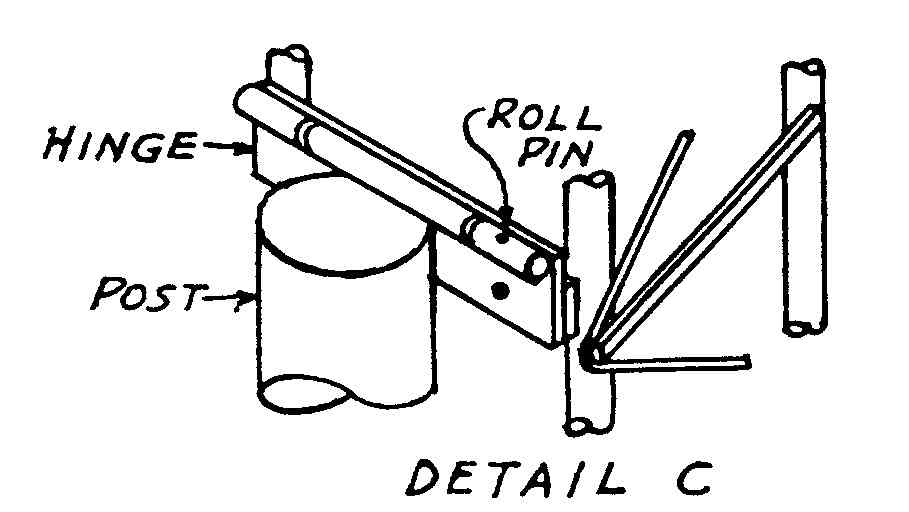
Probably not the smartest idea. Anyway, the pictures you are about to view are the progress of converting the telescoping tower into a tilting / telescoping tower.
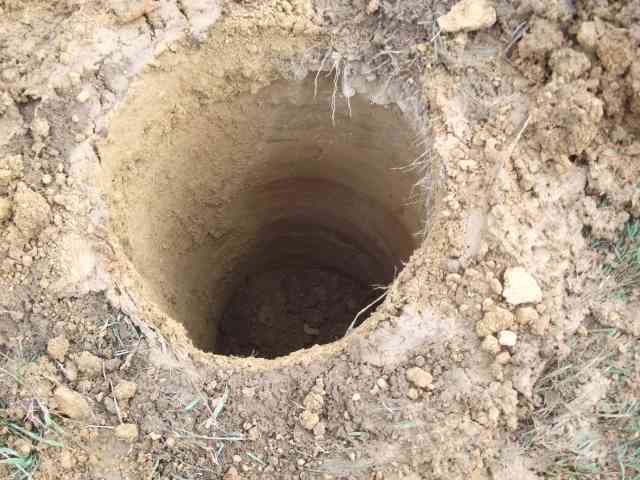
Gotta start with a hole. Thanks to one of neighbors and his tractor, 4 feet of the hole is dug. This is 12" in diameter.

Bob, KC4KUZ carrying the post hole diggers with 6 foot handles and a tamping stick. Time to clean out the hole, and go 8" deeper.
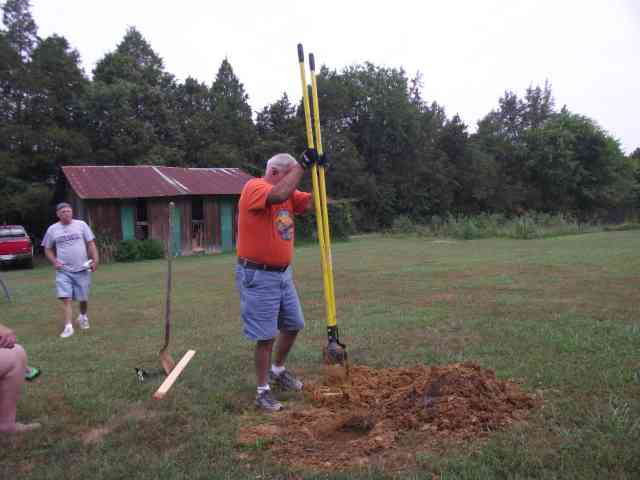
And getting started...

One thing our guys believe in is sharing... Get with it Kenny (KC4OJS).

Well, I ain't able to do much, but I can still swing a hammer... cutting a cap block to go in the bottom of the hole, Chuck, K4CTB, helping.
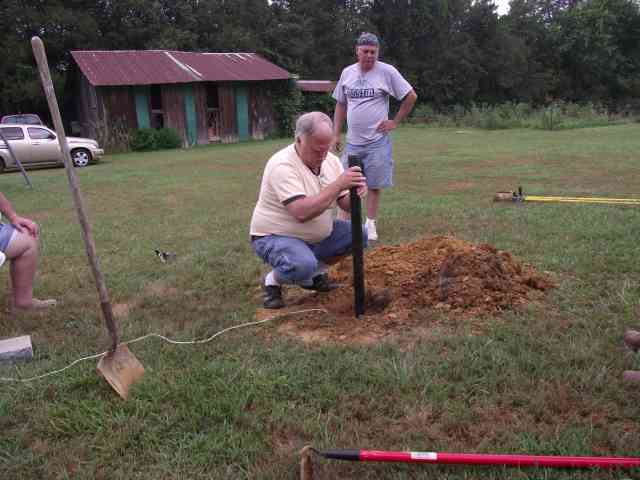
Putting in the 8 foot ground rod... hey, 4' 8" of the hole is already there... makes it easy... The rope has the half cap block on the end, just in case we didn't get it positioned right the first time.
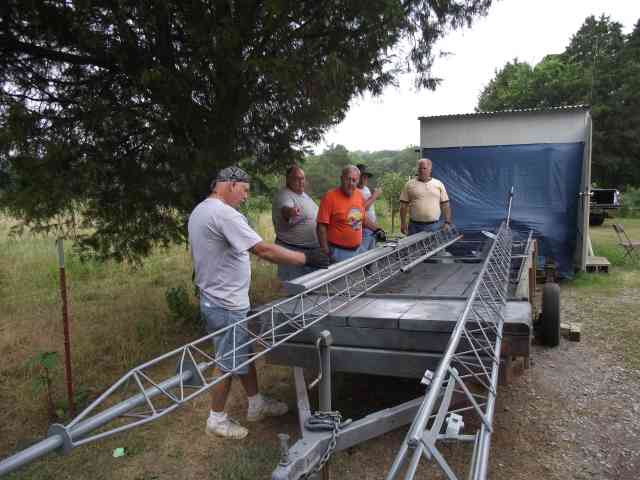
Now, I'm not to sure what is going on, but it must be a committee meeting, because 3 people are pointing... they are just making sure which end is up, and which side faces the house. A note on my version of the "Wonder Pole".. it is made from 2- 13 foot tall sections of 3" diamater, 3/8" wall pipe welded together with 1/2" spacer blocks between the pipe sections, and a 1" diameter pipe welded across inside both uprights for a pivot point.

Ok, meeting's over... back to work...

Push...
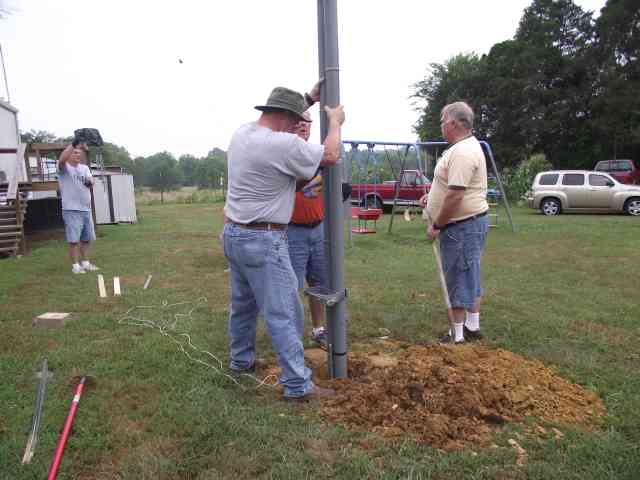
Getting it plumb...
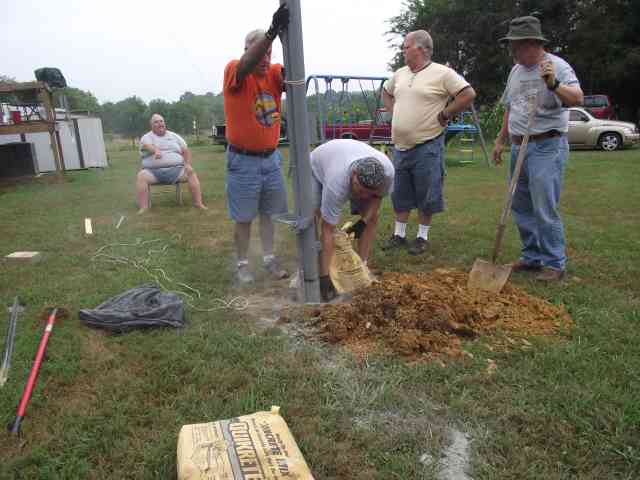
A little dirt, a bag of concrete, a little more dirt, another bag of concrete, and a little more dirt...

Packing it in...
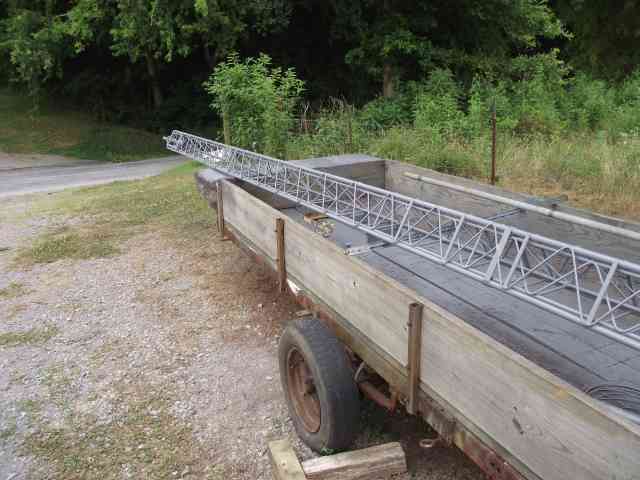
OK, once this bad boy is rigged, in a few days, it will "reach for the sky"...
And, here are the pics from that day...
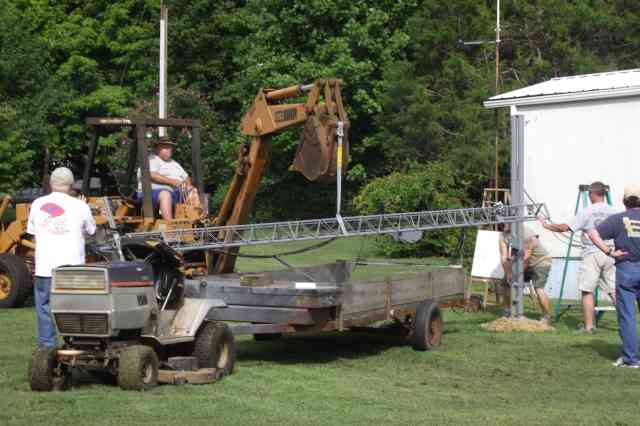
Well, using the neighbor's backhoe was a good idea... until we found out the hydraulics drift like the wind... so...
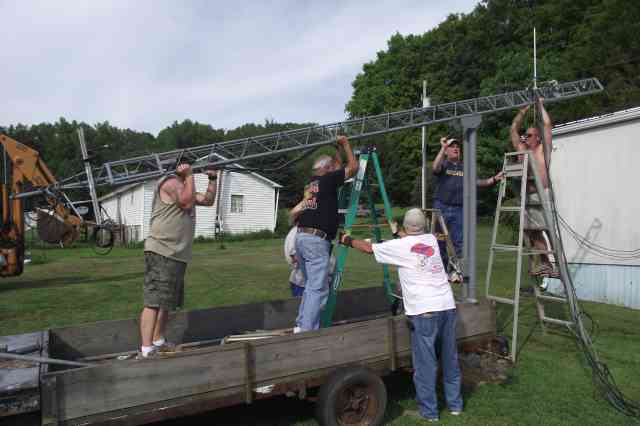
We resorted to the "armstrong" method...

Getting the pin and spacers in place... The pivot point on the tower has a box welded to the tower which spans 1 foot of the tower legs. There is a solid 5/8" diameter pin that goes through the plates and into the pole.

Another committe meeting... how many people does it take to wind on a winch cable?
Both the tilt winch and telescope winch cables are double pull, i.e. from the winch, out, and back.
Moves slowly, but very easy to turn and control.
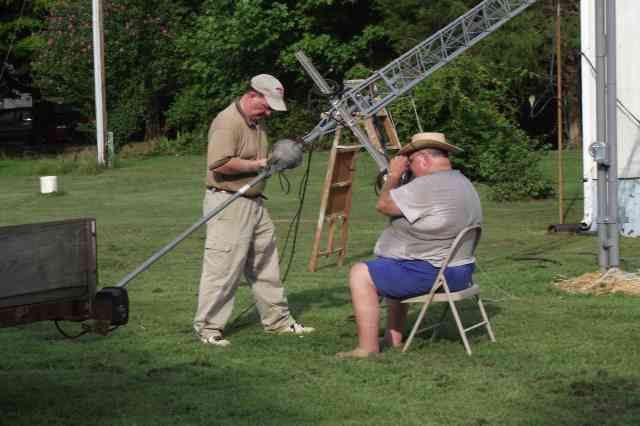
Rotor time... why do they make the hole the rotor cable go in so dang small?
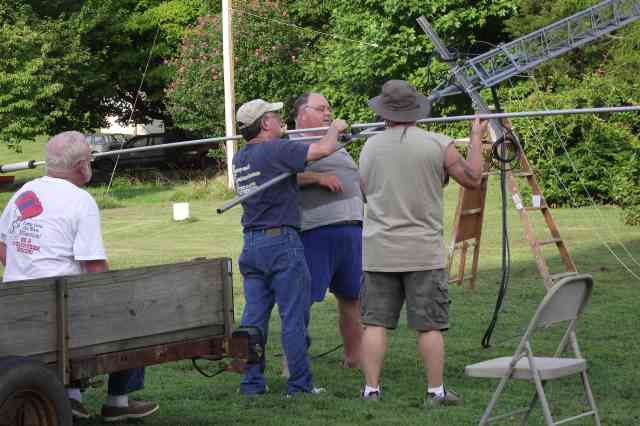
Putting the 10 / 15 / 20M rotatable dipole (soon to add 6M) on top of the rotor...

And with the 40 / 80 / 160M and 60M dipoles tied in place, it starts skyward!

And now it is up!
More to come on this, as there are several things left to do.. boxes on the pole and house with lightning protection to the max, an Ameritron RCS-V8 coax switch with mods to ground all unused antennas and 50V MOVs on the control lines for lighting protection, conduit from the house to the pole, etc, etc.
08-10-2010... as promised, more pictures!
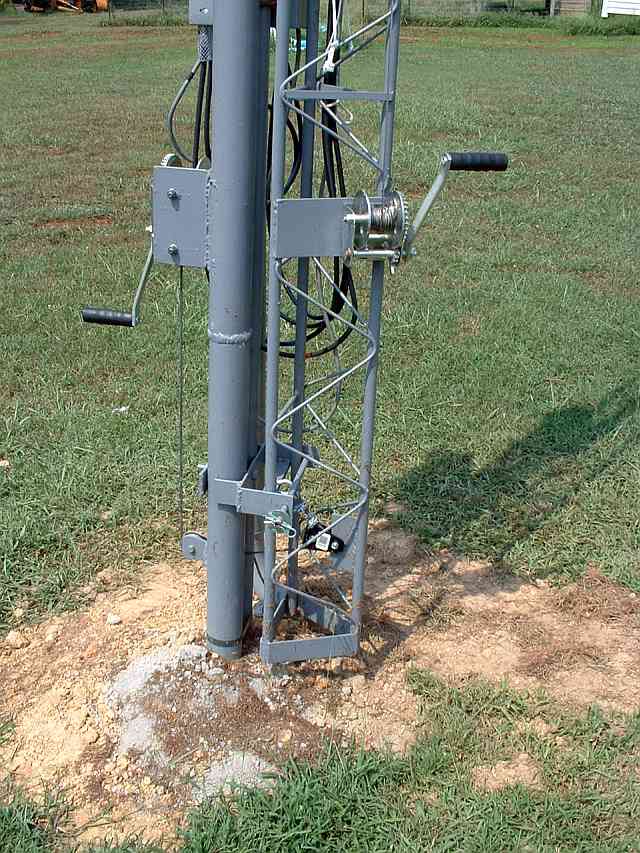
Here is a picture of both the telescoping and tilting winches, pulleys, and lock bracket. Notice the tower itself sets a few inches off the ground.
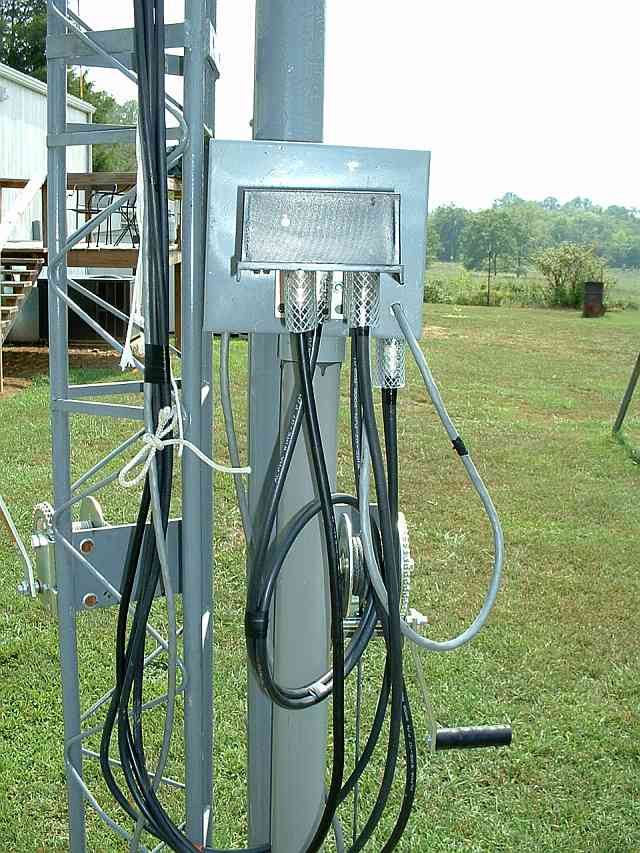
Here is a view of the junction box and remote switch on the pole. I came up with the idea of tubing slid over the connectors, instead of tape.

The remote switch is bolted to the cover of this box. Inside you see the polyphasers, one for HF, and one for VHF/UHF, and one for rotor wires.
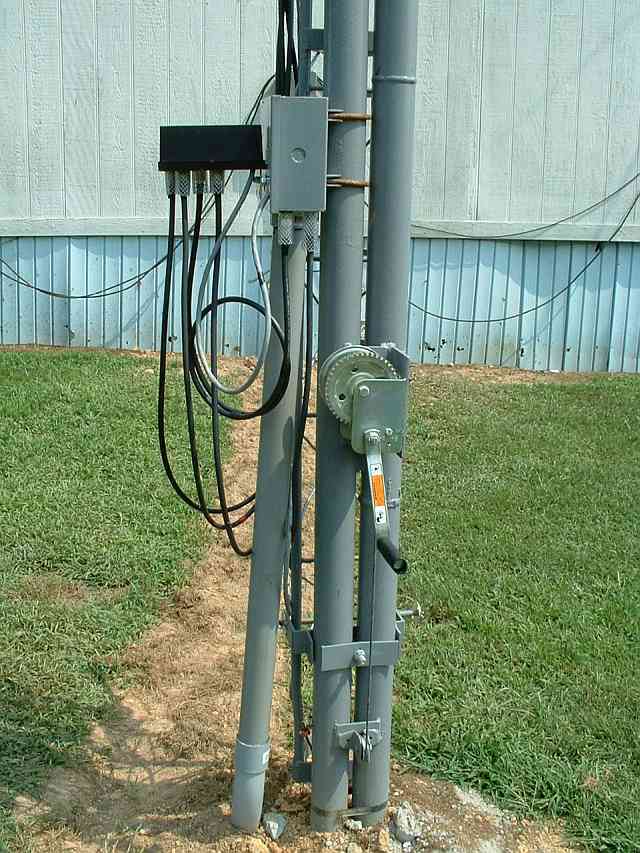
Here is a view that shows the ditch for the 2" conduit buried from the house to the tower. It has 2- buryflex coaxes and 2 control cables in the conduit, and a #6 bare copper connecting the tower ground to the ground at the house.
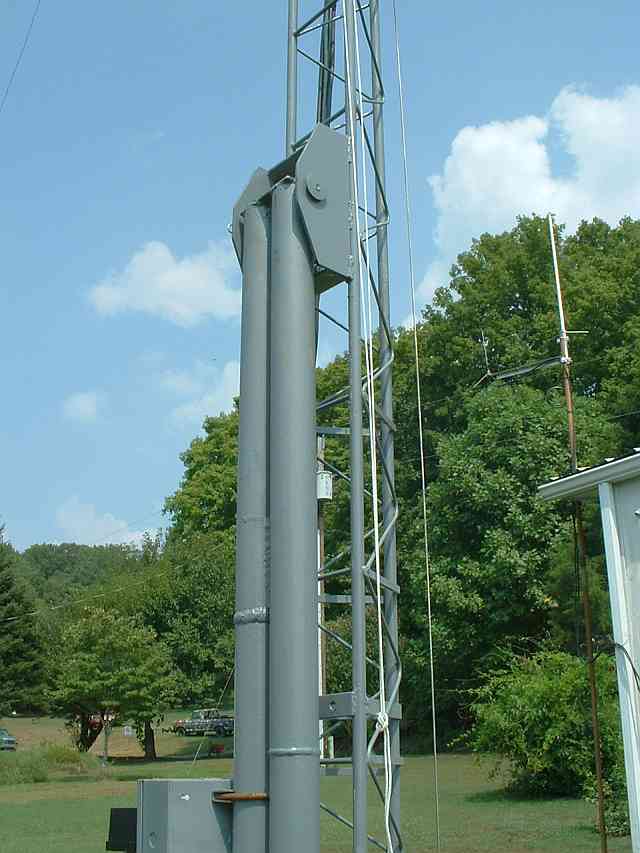
Here is a view of the tilting point modifications on the tower. I don't think it will break... has a 5/8" solid pin...
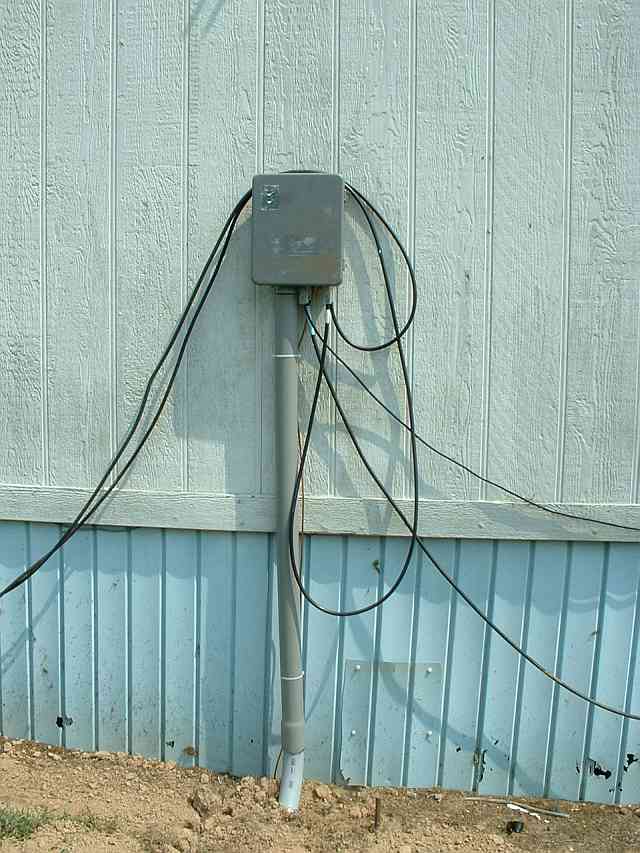
Here is a view of the junction box at the house. Still have some stuff to move at the house, but getting there...

And here is inside the box. The polyphasers in this box are for a VHF/UHF beam and a 220MHz beam. The feedthroughs are for my 2M packet and APRS antennas, both which are DC grounded, but if you look closely at the feed throughs, they are bonded to the ground at this box. Also inside is a polyphaser for the rotor for the beams. The steel wool is to keep varmits out of the shack.
11-04-2010
Well, I now have the rest of the antenna work done (except the 6M add on to the tri-band dipole).

This shows the 4 element 2M horizontal beam for 2M SSB work. I had to exchange the 5 foot mast about to rotor for a 10 foot one.

And this is my setup that stays connected to the 2M / 70Cm rigs 24/7 for Skywarn. top is a Diamond 2M / 70CM vertical, bottom is an MFJ 2M / 70Cm beam with rotator.
Both antennas are "DC Grounded" antennas, and also have Polyphasers in both lines at the entrance to the house, as well as the pole being grounded to the system ground.
We also installed 2 5/8 wave mobile whips on brackets on the eave of our mobile home, one for packet, one for APRS, and cleaned up the cables around the entrance point.
I hope you enjoyed the pics and story!
I want to thank the absolute ARMY of McMinn ARC hams who came out to help me. I can't say enough about the fellowship and servant attitude these folks have. It is what makes a ham radio group function as it should. This project will allow me to once again be able to work on and experiment with antennas, without having to call a crew to work on the tower...
de NA4IT

Probably not the smartest idea. Anyway, the pictures you are about to view are the progress of converting the telescoping tower into a tilting / telescoping tower.

Gotta start with a hole. Thanks to one of neighbors and his tractor, 4 feet of the hole is dug. This is 12" in diameter.

Bob, KC4KUZ carrying the post hole diggers with 6 foot handles and a tamping stick. Time to clean out the hole, and go 8" deeper.

And getting started...

One thing our guys believe in is sharing... Get with it Kenny (KC4OJS).

Well, I ain't able to do much, but I can still swing a hammer... cutting a cap block to go in the bottom of the hole, Chuck, K4CTB, helping.

Putting in the 8 foot ground rod... hey, 4' 8" of the hole is already there... makes it easy... The rope has the half cap block on the end, just in case we didn't get it positioned right the first time.

Now, I'm not to sure what is going on, but it must be a committee meeting, because 3 people are pointing... they are just making sure which end is up, and which side faces the house. A note on my version of the "Wonder Pole".. it is made from 2- 13 foot tall sections of 3" diamater, 3/8" wall pipe welded together with 1/2" spacer blocks between the pipe sections, and a 1" diameter pipe welded across inside both uprights for a pivot point.

Ok, meeting's over... back to work...

Push...

Getting it plumb...

A little dirt, a bag of concrete, a little more dirt, another bag of concrete, and a little more dirt...

Packing it in...

OK, once this bad boy is rigged, in a few days, it will "reach for the sky"...
And, here are the pics from that day...

Well, using the neighbor's backhoe was a good idea... until we found out the hydraulics drift like the wind... so...

We resorted to the "armstrong" method...

Getting the pin and spacers in place... The pivot point on the tower has a box welded to the tower which spans 1 foot of the tower legs. There is a solid 5/8" diameter pin that goes through the plates and into the pole.

Another committe meeting... how many people does it take to wind on a winch cable?
Both the tilt winch and telescope winch cables are double pull, i.e. from the winch, out, and back.
Moves slowly, but very easy to turn and control.

Rotor time... why do they make the hole the rotor cable go in so dang small?

Putting the 10 / 15 / 20M rotatable dipole (soon to add 6M) on top of the rotor...

And with the 40 / 80 / 160M and 60M dipoles tied in place, it starts skyward!

And now it is up!
More to come on this, as there are several things left to do.. boxes on the pole and house with lightning protection to the max, an Ameritron RCS-V8 coax switch with mods to ground all unused antennas and 50V MOVs on the control lines for lighting protection, conduit from the house to the pole, etc, etc.
08-10-2010... as promised, more pictures!

Here is a picture of both the telescoping and tilting winches, pulleys, and lock bracket. Notice the tower itself sets a few inches off the ground.

Here is a view of the junction box and remote switch on the pole. I came up with the idea of tubing slid over the connectors, instead of tape.

The remote switch is bolted to the cover of this box. Inside you see the polyphasers, one for HF, and one for VHF/UHF, and one for rotor wires.

Here is a view that shows the ditch for the 2" conduit buried from the house to the tower. It has 2- buryflex coaxes and 2 control cables in the conduit, and a #6 bare copper connecting the tower ground to the ground at the house.

Here is a view of the tilting point modifications on the tower. I don't think it will break... has a 5/8" solid pin...

Here is a view of the junction box at the house. Still have some stuff to move at the house, but getting there...

And here is inside the box. The polyphasers in this box are for a VHF/UHF beam and a 220MHz beam. The feedthroughs are for my 2M packet and APRS antennas, both which are DC grounded, but if you look closely at the feed throughs, they are bonded to the ground at this box. Also inside is a polyphaser for the rotor for the beams. The steel wool is to keep varmits out of the shack.
11-04-2010
Well, I now have the rest of the antenna work done (except the 6M add on to the tri-band dipole).

This shows the 4 element 2M horizontal beam for 2M SSB work. I had to exchange the 5 foot mast about to rotor for a 10 foot one.

And this is my setup that stays connected to the 2M / 70Cm rigs 24/7 for Skywarn. top is a Diamond 2M / 70CM vertical, bottom is an MFJ 2M / 70Cm beam with rotator.
Both antennas are "DC Grounded" antennas, and also have Polyphasers in both lines at the entrance to the house, as well as the pole being grounded to the system ground.
We also installed 2 5/8 wave mobile whips on brackets on the eave of our mobile home, one for packet, one for APRS, and cleaned up the cables around the entrance point.
I hope you enjoyed the pics and story!
I want to thank the absolute ARMY of McMinn ARC hams who came out to help me. I can't say enough about the fellowship and servant attitude these folks have. It is what makes a ham radio group function as it should. This project will allow me to once again be able to work on and experiment with antennas, without having to call a crew to work on the tower...
de NA4IT